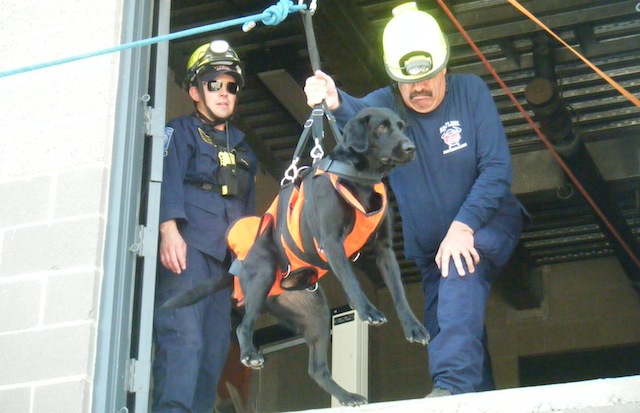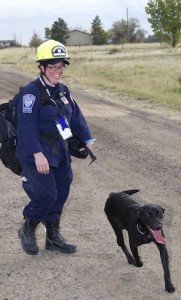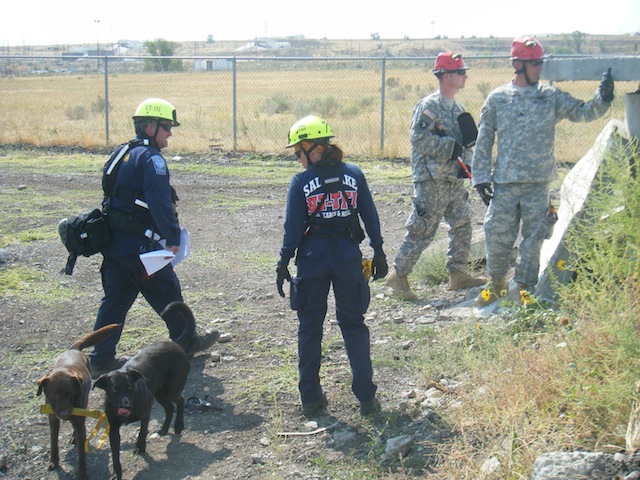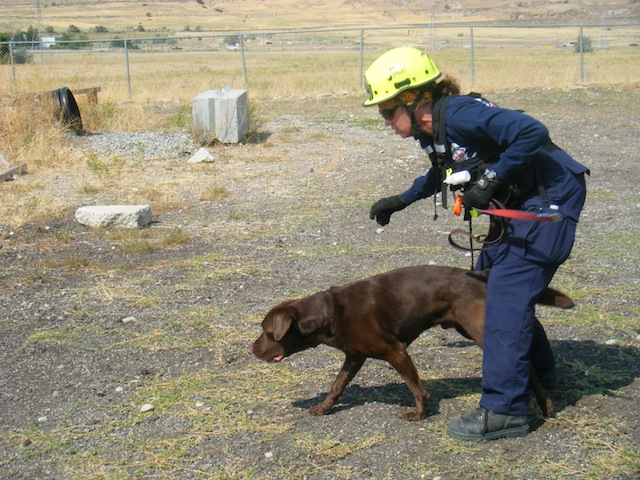Uncommon Jobs: Urban Search & Rescue Veterinarian


I’m honored that Elliott asked me to write about my experiences as an “uncommon veterinarian.” I’m a 1997 graduate of the University of Wisconsin and my regular job has always been as an associate in various small animal practices. Recently, though, I’ve fallen into an opportunity that I didn’t even know existed.
Before I explain my uncommon job, I need to give you some background. When you think of search and rescue dogs, you probably think of the dogs that sniff through forests, tracking lost children or hikers. There are also search and rescue dogs that specialize in urban environments. These urban search and rescue (USAR) dogs searched for survivors under the rubble of the World Trade Center, after the devastation of Hurricane Katrina, and after the 2011 earthquake in Haiti.

USAR is a division of FEMA, the Federal Emergency Management Agency. Each USAR task force maintains people and equipment ready to deploy within four hours of a disaster. Besides dogs and K9 handlers, the team members include paramedics, structural engineers, hazardous materials specialists, heavy rescue specialists, and emergency physicians.
There are only 28 FEMA task forces nationwide; one happens to be in Salt Lake City where I live. There is a list of canine drugs and supplies that the task force needs to maintain in readiness, and for years that cache box was kept at our veterinary hospital because we were open 24 hours and located close to the task force warehouse.
So I became involved in a rather fortuitous way: I just happened to work at the hospital where the task force kept its veterinary supplies. The handlers also brought their dogs to the hospital for routine care, so I became familiar with them. One of the dogs we cared for was “Jake,” a black Labrador retriever who deployed to the World Trade Center after 9/11. He was a frequent visitor up until his death from hemangiosarcoma in 2007. You can read more about Jake on Wikipedia. One of our current dogs, Pilot (pictured above) can also be found on Facebook!

A few years ago, one of the handlers asked me to present a canine first aid class. Many of the handlers are firefighter/paramedics and they asked me many questions about veterinary advanced life support—some so complex I didn’t know the answers! Then in 2011, I was asked by the task force to be the onsite veterinarian for a national canine certification event they were hosting. Watching the dogs and handlers working, seeing the immense dedication of everyone on the team—I was hooked.
I started the application process in the fall of 2011 and officially joined in 2012. My first big adventure with Utah Task Force 1 was a joint exercise with Colorado Task Force 1 in October 2012. It was a planned exercise but was treated like a real disaster, with deployment of 90 people and 7 dogs from our team. Hypothetically, a tornado had hit Denver and done considerable damage. There were two mock-up disaster sites with mannequin and volunteer “victims.” I’m assigned to the medical team (paramedics and ER physicians) so I worked with them and participated in searches when I wasn’t treating the dogs. Fortunately, the only dog injuries were two minor, superficial lacerations.
The people (and dogs) on the task force are all amazingly dedicated, willing to put themselves in harm’s way to save the lives of complete strangers. It is an honor to work with them. Plus, I feel like I’m appreciated. Everyone on the task force calls me “Doc” and respects my skills and education—unlike some of my entitled, self-absorbed clients in private practice!

Of the 28 task forces, only about 12 have veterinarians, since it was only recently that FEMA finally realized that deploying a vet with the K9’s was a good idea. Many of the other task force veterinarians were officially hired for other jobs within the structure, like K9 handler or logistics. However, I think most of the task forces are now interested in getting vets. The head of my task force was recently at a national meeting with the other task forces, and he said that everybody was jealous when they found out he was getting a vet.
In the case of a disaster, I would deploy for up to ten days. I’m fortunate to be in a five-doctor practice, so if I deploy my colleagues can cover for me. Barring deployment, the job only consists of occasional training sessions and weekend exercises. As far as time commitment, it really varies. Through the summer and fall it averaged about one 3-hour block every month or two for me. Some of the training is mandatory (for example, a recent hazardous materials lecture), while other times it is voluntary (a recent helicopter training with the National Guard). Deployments and some of the training are paid.
This is where you can find all the information you’ll need on the FEMA USAR program. If you’re interested in getting involved with disaster response, you can begin to get involved by taking prerequisite courses for free online.
You might also be interested in this article I wrote for Veterinary Economics expanding even further on the roles for veterinarians when disaster strikes.
Please let me know if you have any questions in the comments below!

Comments
Hi Elliot and Laura,
I’m a veterinary student from Canada and I’ve always been interested in getting involved with SAR, hopefully one day as both a handler and vet. I was wondering if you might know anyone in Canada or if you could direct me to where I might get more information. I have no idea where to start. I like the idea of being able to practice and still do this sort of thing on the side.
Hi Vishal,
This is Laura. I know that Canada has five USAR task forces that are similar to the American task force of which I’m a member. More info at: http://www.publicsafety.gc.ca/prg/em/usar/index-eng.aspx
Or try the Canadian Search Dog Association at: http://canadiansearchdog.com/
Good luck in your studies!
This is what it’s all about 🙂 I just graduated and I am in the middle of a small animal internship program, and suddenly realizing I don’t know what I want to do with my career! After reading this I’m currently trying to get involved myself. I’ve always been interested in helping out in disaster situations. I think this is just what I’ve been looking for! I’m living in California currently but will be moving back East to the NJ area this summer. Do you have any advice on where to get started? Thanks for posting!
Hey Vanessa, thank you for your comment! That’s great that you’re exploring some more unique options of how to use your veterinary training. I’m sure a USAR or other emergency response team would love to have someone with your clinical training coming out of the internship program. I just did a quick search and found NJ’s USAR site. You could get in touch with them to see if they could use a veterinarian. The nice thing about NJ is that it’s so close to other states, too, so depending on where you are you could also contact the teams from NY, PA, DE, etc. Keep us posted on how things turn out, and good luck! http://www.state.nj.us/njoem/taskforce1/index.html
Thank you so much for the help! I’ll keep you all posted!
Hi Vanessa,
You might also contact Dr. Cindy Otto at Penn. She is on PA-TF1 and deployed after 9/11 and is *the* authority on working dogs 🙂
Laura
Hi! Elliot, I’m from india can i join your team as a dedicated vet…
Hi Vimal, maybe one day I’ll be in some position where I can hire on a dedicated veterinarian like you! For now, though, I’m very happy to have you as one of the rare tribe of present and future uncommon veterinarians…